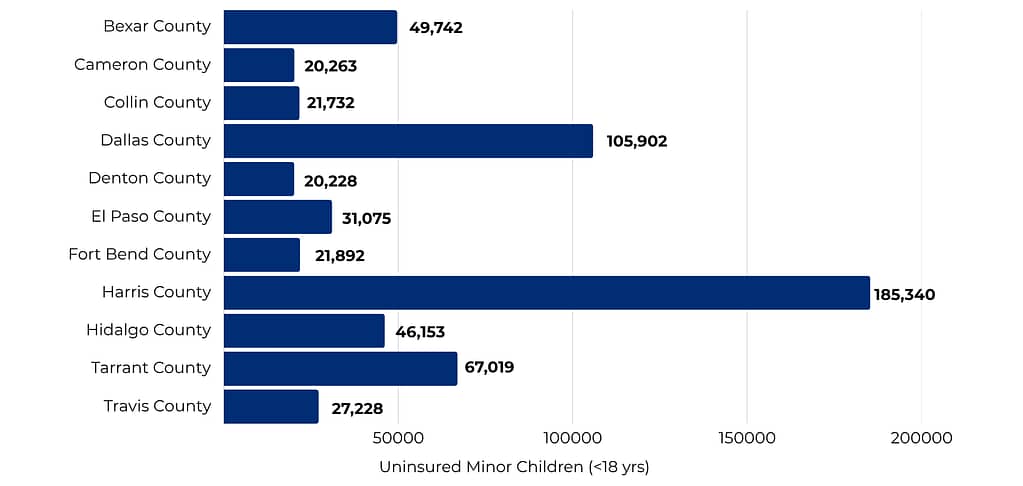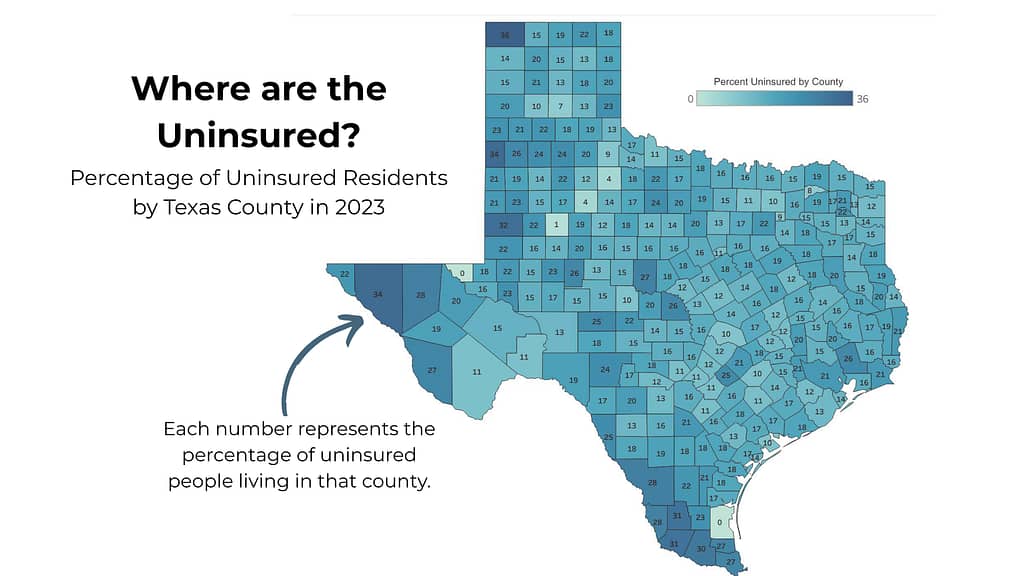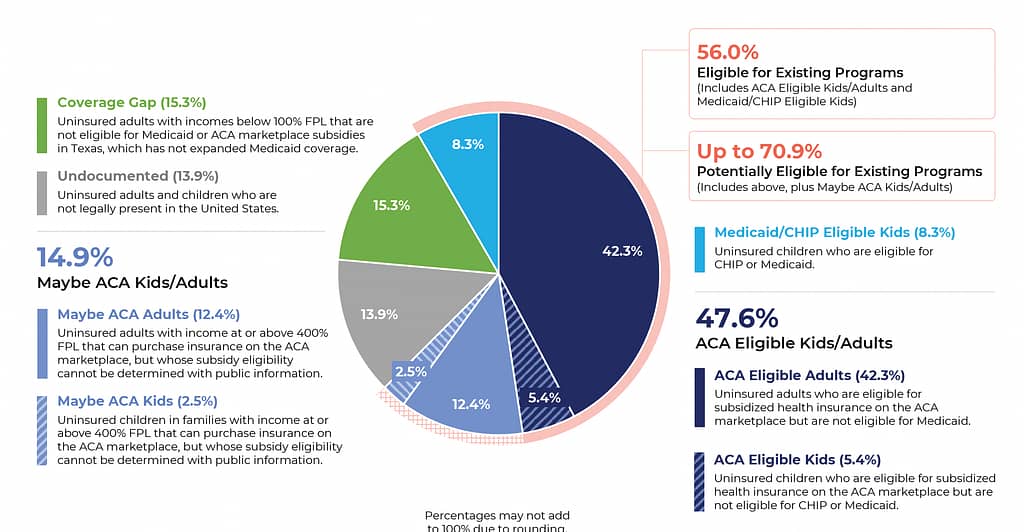Understanding Texas’ uninsured
This is a preview of our Texas 2036 newsletter with our look at Texas’ uninsured and how to close the coverage gap. To receive this weekly look at our work, sign up here.
The Story of Texas’ Uninsured

Too many Texans are falling through the cracks of our health care system.
While Texas has taken steps to expand access, nearly two million uninsured residents likely qualify for affordable coverage but aren’t enrolled.
That’s why we’re digging into the data to understand who’s being left behind, why and how Texas can close the coverage gap.
Nearly 1 million uninsured Texas children
Number of uninsured children in the top 10 Texas counties with the largest total uninsured populations, 2023
 Source: 2023 U.S. Census data
Source: 2023 U.S. Census data
Nearly one in 5 uninsured Texans are under the age of 19. Of these uninsured children, more than 200,000 of them are under the age of 6, according to the latest U.S. Census data.
Why does this matter? Between 79% and 93% of uninsured Texas children are already eligible for free or subsidized insurance.
Texas 2036 data estimated the number of uninsured Texas children and their eligibility from 2022:
- Just under half (48%) of uninsured Texas children are eligible for Medicaid or CHIP.
- Nearly a third (31%) are eligible for subsidized ACA coverage, while an additional 14% *may* be eligible, depending on particular local income and market conditions.
Legislation on the Table: House Bill 321/Senate Bill 238 by Rep. John H. Bucy III (D-Austin) and Sen. Nathan Johnson (D-Dallas) proposes to streamline and simplify Medicaid enrollment for children by allowing Texas to use data from other state benefit programs to automatically verify eligibility for Medicaid.
Where are Texas’ uninsured?

Key findings from a recent county-level analysis by Texas 2036:
- Harris County has the largest number of uninsured people overall.
- 11 counties each have 100,000+ uninsured residents: Harris, Dallas, Tarrant, Bexar, Hidalgo, El Paso, Travis, Cameron, Collin, Fort Bend and Denton.
- The largest uninsured populations are concentrated in the Texas Triangle (Houston, San Antonio, Austin, Dallas and Fort Worth) — due to higher population density. But several rural counties in the Panhandle, West Texas and the Lower Rio Grande Valley have the largest percentage of their population uninsured.
- In nearly all counties, males make up the largest share of the uninsured.
- The most common age group without insurance? 26–34 year-olds, across the top 10 counties, except Fort Bend.
A Closer Look: Where are the uninsured located in Texas? Part 1: The county view
Did you know? Five million Texans are uninsured – the largest percentage (over 16%) of any state and more than double the national average.
 Texas 2036 findings: Who are the Uninsured?
Texas 2036 findings: Who are the Uninsured?
In 2023, we released the “Who are the Uninsured?” report, which followed a multi-year study to identify Texas’ uninsured and the barriers they face to gain affordable coverage.
The top takeaway: Most uninsured Texans want coverage, but struggle to access it due to systemic, financial and psychological challenges.
Deeper Dive: The barriers to health care access
Primary reasons for not having health insurance (% of respondents)
 Source: Texas 2036’s “Who are the Uninsured?”
Source: Texas 2036’s “Who are the Uninsured?”
Despite a strong desire for health insurance, millions of Texans remain uninsured. The reasons for lacking insurance, however, varies.
We take a look at some of the top 2 reasons many Texans are uninsured.
1. Health care affordability (real and perceived)
Eligibility for subsidized health insurance among uninsured Texans
 Source: Texas 2036’s “Who are the Uninsured?”
Source: Texas 2036’s “Who are the Uninsured?”
The misconception: Many uninsured Texans believe insurance is unaffordable even when they qualify for free or low-cost plans.
The reality: Two million uninsured Texans are income-eligible for free ACA plans or children’s programs like Medicaid or CHIP, according to Texas 2036 research.
Last year, ACA enrollment in Texas reached a record high, with nearly four million Texans securing coverage — a jump of over one million from the previous year.
Legislation on the Table: SB 1409/HB 2290 by Sen. Tan Parker (R-Flower Mound) and Rep. Ann Johnson (D-Houston) aims to expand access to affordable health insurance options for college students. The bill passed the Legislature and is on Gov. Greg Abbott’s desk.
Can Medicaid expansion address Texas’ uninsured?

Expanding Medicaid would help approximately 15% of the state’s uninsured population.
HOWEVER, 85% of uninsured Texans would remain uncovered, even if the state adopted Medicaid expansion tomorrow.
Those left out include:
- Middle-income individuals who earn too much to qualify
- People who are eligible for existing programs like the ACA Marketplace but are unenrolled
2. Getting coverage is confusing and complex

The problem: Many uninsured Texans who attempt to enroll in health insurance, particularly through the ACA Marketplace, report that the process is confusing, frustrating and often abandoned, a Texas 2036 focus group found.
What they told us: The application is too long, too invasive early on and hard to navigate due to unfamiliar terminology and lack of clear plan comparisons. Some also cited aggressive marketing and spam, decision paralysis and lack of support as key reasons why they didn’t pursue coverage.
Learn more: The State of Health Care for Texas Families
Emergency rooms are a go-to for uninsured care
A Texas 2036 focus group found high reliance on emergency departments among uninsured individuals, even for preventive care, highlighting the gap in regular, affordable health care access.
Learn more: Fixing health care the Texas way
More insured Texans equals a healthier state

Most uninsured Texans want coverage but face systemic, financial and informational barriers—challenges that data-driven, targeted policies can help overcome.
That’s why Texas 2036 is committed to equipping lawmakers with accurate data to drive meaningful solutions and expand access to affordable care for all Texans.
